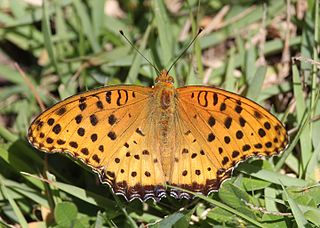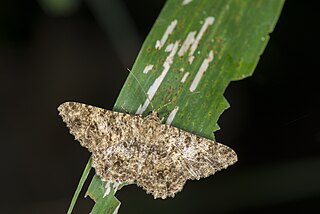
Earwigs make up the insect order Dermaptera. With about 2,000 species in 12 families, they are one of the smaller insect orders. Earwigs have characteristic cerci, a pair of forceps-like pincers on their abdomen, and membranous wings folded underneath short, rarely used forewings, hence the scientific order name, "skin wings". Some groups are tiny parasites on mammals and lack the typical pincers. Earwigs are found on all continents except Antarctica.

Apatura iris, the purple emperor, is a Palearctic butterfly of the family Nymphalidae.

Graphium sarpedon, the common bluebottle or blue triangle in Australia, is a species of swallowtail butterfly that is found in East, South and Southeast Asia, as well as eastern Australia. There are approximately sixteen subspecies with differing geographical distributions.

Papilio (Chilasa) paradoxa, the great blue mime, is a swallowtail butterfly found in India and parts of South-East Asia. The butterfly belongs to the mime subgenus, Chilasa, of the genus Papilio. It is an excellent mimic of different species of Euploea.

Luthrodes pandava also called the Plains Cupid or cycad blue, is a species of lycaenid butterfly found in South Asia, Myanmar, United Arab Emirates, Indochina, Peninsular Malaysia, Singapore, Taiwan, Java, Sumatra and the Philippines. They are among the few butterflies that breed on cycads, known for their leaves being toxic to most vertebrates.

Lampides boeticus, the pea blue, or long-tailed blue, is a small butterfly that belongs to the lycaenids or gossamer-winged family.

The Indian fritillary is a species of butterfly of the nymphalid or brush-footed family. It is usually found from south and southeast Asia to Australia.

Cerura vinula, the puss moth, is a lepidopteran from the family Notodontidae. The species was first described by Carl Linnaeus in his 1758 10th edition of Systema Naturae.

Diacrisia sannio, the clouded buff, is a moth of the family Erebidae. The species was first described by Carl Linnaeus in his 1758 10th edition of Systema Naturae.

Spilosoma lubricipeda, the white ermine, is a moth of the family Erebidae. It is found throughout the temperate belt of Eurasia from Europe through Kazakhstan and southern Siberia to Amur Region, China, Korea and Japan. In China several sibling species occur.

Phragmatobia fuliginosa, the ruby tiger, is a moth of the family Erebidae.

Catochrysops strabo, the forget-me-not, is a small butterfly found in Asia that belongs to the lycaenids or blues family. The species was first described by Johan Christian Fabricius in 1793. It is found in Sri Lanka, India, from Sikkim to Indochina and in Sundaland, Sulawesi and the Philippines.

Racotis boarmiaria is a species of moth of the family Geometridae described by Achille Guenée in 1857. It is found in India, Sri Lanka, Maldives, Myanmar, China, Japan, Taiwan, Indonesia, Bhutan and Malaysia.

Eucosma cana, the hoary bell, is a species of moth of the family Tortricidae.

Mimathyma nycteis is a butterfly found in the East Palearctic that belongs to the browns family.
Andixius is a genus of planthopper insects belonging to the family Cixiidae. The genus contains 4 species. Three species found in China, the other species from Japan.
Andixius nupta is a species of planthopper belonging to the family Cixiidae. It is endemic to Japan.

Andixius trifurcus is a species of planthopper belonging to the family Cixiidae. It is endemic to Yunnan, China.
Andixius venustus is a species of planthopper belonging to the family Cixiidae. It is endemic to China.

Neoproutista is a small genus of planthoppers from the family Derbidae, tribe Zoraidini, currently (2024) with 6 described species. The species of the genus are found in southern Asia from India and Sri Lanka in the West to Taiwan and southern China in the East. In south-eastern Asia there are reports from Thailand, the southern Philippines, Malaysia, and parts of Indonesia. The species are similar to the species in the genus Pamendanga, but have much shorter antennae. Apparently, live specimens can be easily recognized by the way the insects usually carry their forewings when at rest. These are raised above the body like in other genera of Zoraidini, but are held close together, parallel to each other and overlapping each other. The general colouration of the body is typically brownish to black, sometimes with white or reddish marks. The forewings are black, dark brown or brown with white marks along the costal and apical margins. The veins are mainly brown to reddish brown. The hind wings are less than half as long as the forewings and are usually dark brown, often lighter near their base.

















